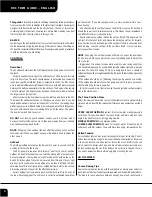
M
AINTENANCE
S
ECTION
7
4627 9/04
NOTE:
The repair of cosmetic (non-structural) gelcoat stress cracks is not
included under the terms of the Carver Limited Warranty.
7.2.1.1 Gelcoat Repair
Cosmetic repair of minor gelcoat nicks and scratches is not difficult nor does
it require the use of special or unique tools. Any boat owner with a little
practice can make visually satisfying repairs. Repairs to fiberglass lami-
nates or structural fiberglass components are best left to the experienced
technicians at your Carver Dealer.
A gelcoat repair kit is available from your Carver Dealer (Carver part
number 82036-03). This kit includes color matched gel, gel hardener and
detailed instructions on making gelcoat repairs.
7.2.1.2 Gelcoat Blisters
While fiberglass is a durable and economical material, it is not indestruc-
tible. The most commonly known problem associated with fiberglass is
blistering. These blisters generally form in the gelcoat or in the outer most
layer of laminate. They can range in size from microscopic to two inches or
larger in diameter.
The appearance of fiberglass blisters does not indicate structural problems
or faulty hull lamination. Gelcoat blisters form through a natural process
and are quite common. If you discover blisters on the underwater portion of
your boat’s hull, contact your Carver Dealer.
7.2.2 Hull Bottom
The underwater portion of your boat’s hull is coated with a high-quality,
factory-applied coat of anti-fouling bottom paint, applied after the hull has
been carefully prepared. The paint has a high copper content and anti-
fouling elements that retard the growth of marine life on the bottom of your
boat’s hull. The anti-fouling elements in this paint have a limited life span,
usually from one to three years, depending on how and where you use your
boat.
Inspect the hull bottom once a year. If you see gelcoat showing through the
bottom paint, repaint the hull. Be sure to use a paint that is compatible
with the factory-applied paint. Failure to do so can void your bottom paint
warranty. Also make sure the paint is formulated for the type of water you
operate the boat in. See your Carver Dealer for assistance in selecting an
appropriate bottom paint.
To prepare the hull bottom for painting, lightly sand the existing paint with
80 grit or 100 grit sandpaper. Remove all dirt and sanding residue from the
hull. Apply the new paint using a brush, roller or sprayer. If you wish to
apply a second coat, allow the first coat to dry before proceeding.
Summary of Contents for 46 VOYAGER
Page 1: ...46 Voyager Owner s Guide HIN CDR 2005 Version 1...
Page 2: ......
Page 4: ......
Page 18: ......
Page 50: ...DC ELECTRICAL SYSTEM SECTION 2 4627 5 04 C4078B DC CONTROL CENTER C4046B UP...
Page 61: ...SECTION 2 DC ELECTRICAL SYSTEM 4627 5 04 2 5 DC Wiring Schematic C4081D 1...
Page 62: ...DC ELECTRICAL SYSTEM SECTION 2 4627 5 04 C4081D 2...
Page 87: ...SECTION 3 AC ELECTRICAL SYSTEM 4627 5 04 C4079D 2...
Page 88: ...AC ELECTRICAL SYSTEM SECTION 3 4627 5 04 C4080D 1 3 8 2 220V 50Hz Europe Australia...
Page 89: ...SECTION 3 AC ELECTRICAL SYSTEM 4627 5 04 C4080D 2...
Page 90: ...AC ELECTRICAL SYSTEM SECTION 3 4627 5 04...
Page 124: ...PROPULSION SECTION 5 4627 10 02...
Page 136: ...OPERATING AND MANEUVERING SECTION 6 4627 10 02...
Page 167: ......
















































